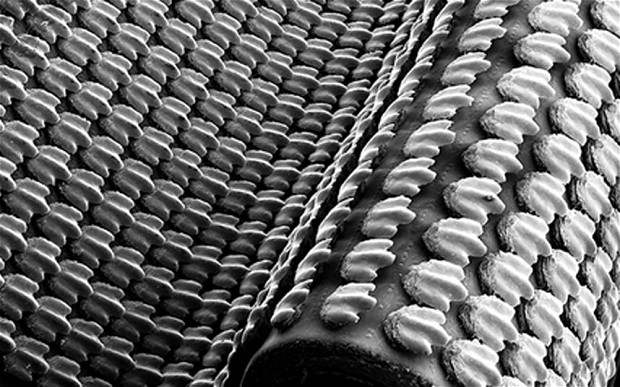For years, engineers, scientists and researchers have looked to nature to discover ways in which to enhance man-made products through a scientific process called biomimetics, which is the mimicking of nature and natural forces. From swim suits to racing cars to clothes, humans have mimicked the mechanics, appearance and mobility of other animals in efforts to increase their speed, movement and even awareness of their surrounding environment. In a more recent discovery, scientists produced a 3-D model of shark skin that displayed tooth-like bristles which were never before seen as detailed as they were in the newest model. Thanks to the power of 3-D modeling, researchers now understand how these ‘denticlesâ, as they dubbed them, alter currents and allow the shark to propel through the water.
Researchers spent nearly a year using 3-D printing to mimic a layer-by-layer duplicate of shark skin. However, since the resolution of 3-D printers is limited, the artificially created denticles were about 10 times larger than the natural ones found on sharks. Despite this drawback, when the artificial skin was put to the test, it showed a 6.6% increase in swimming speed while using 5.9% less energy. The artificial shark skin was attached to a paddle and placed in a water tank. At first, researchers assumed that the shark’s skin reduced the drag of the water, allowing the paddle to move more swiftly. But by paying closer attention, they noticed that the skin actually strengthened the paddle’s thrust instead, which they called “the engine of propulsion”. When compared to the mobility of sharks that the researchers had previously studied, they were surprised to find that the 3-D model of the shark skin actually moved and bent in similar ways that the sharks did when they swam through different currents. Though scientists have gone so far as to envision denticle-laden swimsuits, they believe that it would take decades for that type of design to actually be transferred onto textile surfaces. They are still at the beginning stages of understanding exactly how and on what surfaces this artificial skin works best.
Professor George Lauder of Harvard University, who is the leading researcher in this project, commends 3-D technology for its assistance in providing such a detailed and advanced impression of objects that owe years to biomimetic research. By using this new technology, other man-made materials whose designs were dependent on biomimetics have been tweaked so as to enhance their usage. Scientists, however, are still curious to know what causes this enhancing effect in materials. They are currently testing how even a slight change in spacing, durability, and shape can alter the object’s mobility and mechanics. In an interview by BBC, Professor Lauder expressed his enthusiasm about how much his work and research helps us to not only understand the natural world but to also imbue it in our everyday lives, “It pays us to understand how the natural world works…Millions of years of evolution give us solutions to problems that
we may not have thought of.”









